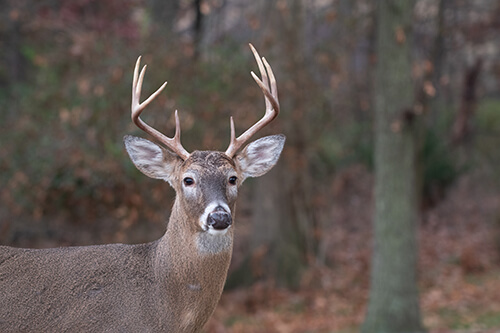Help deer pay their ‘nutritional’ bills
Aug 03, 2020

In the world of deer hunting, we want an abundant, healthy deer population with lots of trophy bucks. However, too often nutritional resources aren’t available for an abundance of huge deer. In fact, mammals have a natural priority list of how they use nutrients. Deer place a low priority on producing large bodies and growing huge antlers. Generally, mammals use nutrients in the following order:
1. Basal metabolism — Nutrients will first be used for basic body functions such as breathing, heartbeat, and blood circulation.
2. Movement — Nutrients will next be used to allow animals to move around to find food and water to sustain life.
3. Growth – Immature animals will use nutrients to grow and reach maturity.
4. Body weight and condition maintenance — If sufficient nutrients are available, animals will not continue to use body reserves as energy and will maintain their weight and condition.
5. Maintenance of pregnancy — Pregnant females will use nutrients to avoid abortion due to lack of nutrients (starvation).
6. Milk production — Females with live, unweaned offspring will use nutrients to produce milk.
7. Adding to energy reserves/weight gain — Animals will store fat for energy reserves and may store excess minerals in bones and/or organs.
8. Reproduction — If nutritional resources are sufficient enough for all the above priorities, cycling, courting, breeding, and pregnancy will occur. Increasing the population will not likely occur when nutritional resources are limited.
9. Expression of secondary sex characteristics – Bright, shiny hair coats in animals, long colorful feathers in birds, and big, heavy antlers in deer are possible only when these other nutritional bills are paid.
Now that we know large populations, heavy body weights and massive antlers are not a deer’s highest priorities, especially when nutrients are lacking. So, what can we do to help assure we have larger populations and bigger deer?
Nutritional supplements such as attractants, feeds, and minerals strategically help assure our deer do not suffer from any deficiencies. Better yet, supplements can provide nutritional abundance so deer will grow, reproduce, and develop antlers that meet our goals.
Energy (calories) are involved in all functions listed above, and animal populations just don’t thrive with limited calories. Providing high-energy supplements will keep calories from being the limiting factor in your deer herd’s size and overall health.
Protein is often associated with reproduction, immunity, and muscle mass. So, when energy is sufficient but protein is lacking, deer health and body weight may suffer. Antler growth requires protein, energy, and abundant minerals. In the eastern U.S., soils are often deficient in certain minerals. Supplementing your deer herd with calcium, phosphorus, magnesium, and zinc will help bucks produce antlers to their genetic potential.
Choose and feed supplements that provide energy, protein, vitamins, and minerals. Balance is important, too. The absence of one nutrient or abundance of another may not allow deer to perform to your expectations.
Many people use deer as a source of recreation and enjoyment. Nutritional supplementation now can reduce your disappointment this fall. For more information, visit your Co-op’s wildlife and hunting experts today!
1. Basal metabolism — Nutrients will first be used for basic body functions such as breathing, heartbeat, and blood circulation.
2. Movement — Nutrients will next be used to allow animals to move around to find food and water to sustain life.
3. Growth – Immature animals will use nutrients to grow and reach maturity.
4. Body weight and condition maintenance — If sufficient nutrients are available, animals will not continue to use body reserves as energy and will maintain their weight and condition.
5. Maintenance of pregnancy — Pregnant females will use nutrients to avoid abortion due to lack of nutrients (starvation).
6. Milk production — Females with live, unweaned offspring will use nutrients to produce milk.
7. Adding to energy reserves/weight gain — Animals will store fat for energy reserves and may store excess minerals in bones and/or organs.
8. Reproduction — If nutritional resources are sufficient enough for all the above priorities, cycling, courting, breeding, and pregnancy will occur. Increasing the population will not likely occur when nutritional resources are limited.
9. Expression of secondary sex characteristics – Bright, shiny hair coats in animals, long colorful feathers in birds, and big, heavy antlers in deer are possible only when these other nutritional bills are paid.
Now that we know large populations, heavy body weights and massive antlers are not a deer’s highest priorities, especially when nutrients are lacking. So, what can we do to help assure we have larger populations and bigger deer?
Nutritional supplements such as attractants, feeds, and minerals strategically help assure our deer do not suffer from any deficiencies. Better yet, supplements can provide nutritional abundance so deer will grow, reproduce, and develop antlers that meet our goals.
Energy (calories) are involved in all functions listed above, and animal populations just don’t thrive with limited calories. Providing high-energy supplements will keep calories from being the limiting factor in your deer herd’s size and overall health.
Protein is often associated with reproduction, immunity, and muscle mass. So, when energy is sufficient but protein is lacking, deer health and body weight may suffer. Antler growth requires protein, energy, and abundant minerals. In the eastern U.S., soils are often deficient in certain minerals. Supplementing your deer herd with calcium, phosphorus, magnesium, and zinc will help bucks produce antlers to their genetic potential.
Choose and feed supplements that provide energy, protein, vitamins, and minerals. Balance is important, too. The absence of one nutrient or abundance of another may not allow deer to perform to your expectations.
Many people use deer as a source of recreation and enjoyment. Nutritional supplementation now can reduce your disappointment this fall. For more information, visit your Co-op’s wildlife and hunting experts today!